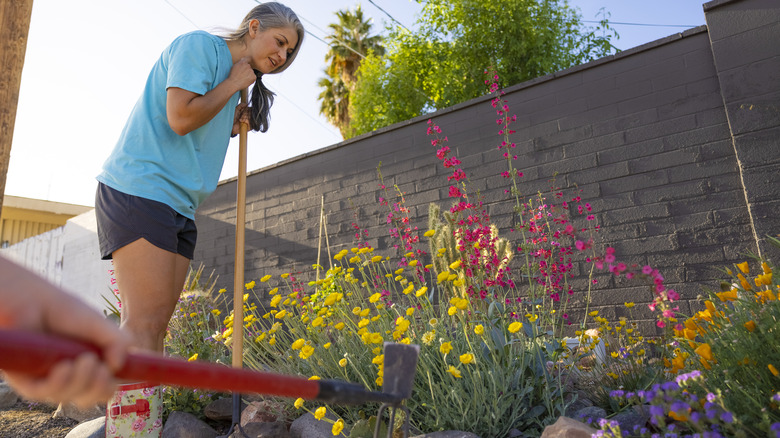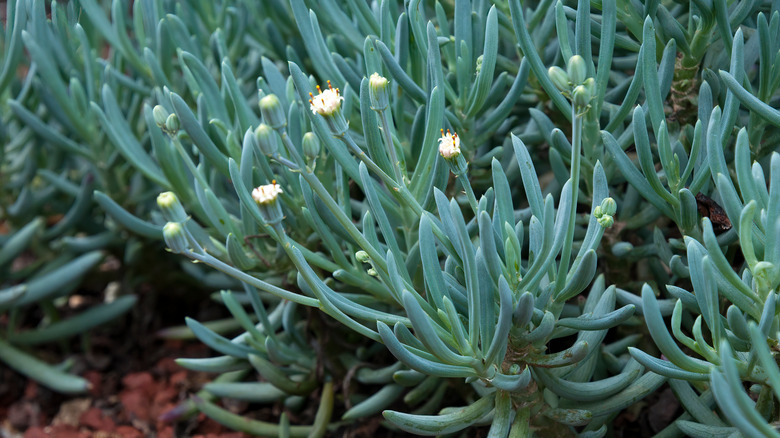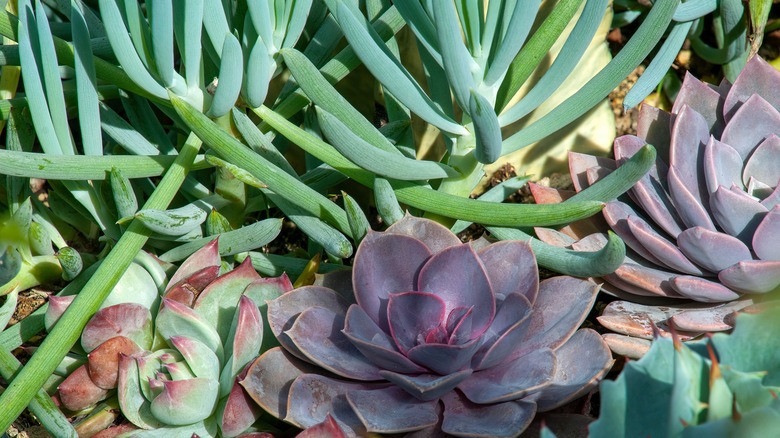The Succulent Ground Cover That'll Make Purple Perennials Stand Out In The Garden
It can be a challenge to find a good ground cover for hot and dry areas. Finding flora that also provides unusual color and texture that complements other plants can be even more difficult. Luckily, the distinctive blue chalkstick plant does just that. Their pale blue foliage and cute white flowers allow nearby purple perennials to really stand out.
The term blue chalksticks can be used to refer to two closely related species of succulents, Senecio serpens, also sometimes called Curio repens, and Senecio mandraliscae. Senecio serpens is lower and slower growing than the taller and more aggressive Senecio mandraliscae. While blue chalksticks are native to South Africa, they are perennial in USDA zones 9 through 12. They can also be grown outdoors in the summer and brought inside for winters in colder regions, as these colorful succulents also thrive indoors. Amazingly, blue chalksticks aren't just drought tolerant — they're also fire resistant, a valuable trait that should endear them to gardeners living in areas prone to wildfires. There is a lot to love about these plants, but gardeners with pets or young children should use caution, as blue chalksticks are toxic, and according to The North Carolina Cooperative Extension, can even cause liver damage. Additionally, all gardeners should be sure to wear gloves when working with blue chalksticks, as their sap can irritate skin.
Caring for blue chalksticks
Blue chalksticks are generally propagated from cuttings and bought as live plants. Senecio mandraliscae can be easily found at garden centers, while Senecio serpens plants are often found at specialty plant shops. When looking for the best place to plant your succulents, remember that blue chalksticks thrive in full to part sun locations, with part sun being best if they are likely to be subjected to extremely high temperatures. Blue chalksticks grow best when temperatures are between 70 and 80 degrees Fahrenheit, but they can tolerate temperatures up to around 100 degrees.
Blue chalksticks require dry and well-draining soil with a sandy texture to grow well and avoid root rot. As they require a neutral soil pH, it's best to measure the pH of your soil to ensure you're meeting the plants' needs. Blue chalksticks seldom, if ever, require fertilizing and can grow well with minimal watering during all but the hottest parts of summer. When in doubt, it's better to under-water succulents than to over-water them.
Using blue chalksticks in the garden
Blue chalksticks are a great way to jump on the xeriscaping trend and conserve water in your garden. Because Senecio serpens only grows around 8 inches tall but can spread up to 3 feet wide, it makes an excellent option for the front of borders and can act as a living mulch around other drought tolerant plants. Senecio mandraliscae, on the other hand, can grow close to 3 feet tall, making it a better option for the middle of borders.
Both types of blue chalksticks brilliantly complement drought-tolerant perennials like penstemon and purple sage and allow their purple flowers to really pop. Succulents with purple leaves also look stunning next to blue chalksticks. To tie your garden together, consider incorporating boulders and different types of rocks into your landscaping around the plants to create an elegant southwestern or Mediterranean-style rock garden, perfect for deserts. The Senecio serpens will slowly spread around the rocks and unify the entire look.



